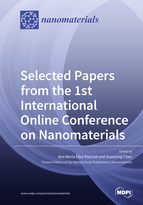Selected Papers from the 1st International Online Conference on Nanomaterials
A special issue of Nanomaterials (ISSN 2079-4991).
Deadline for manuscript submissions: closed (30 April 2019) | Viewed by 30218
Special Issue Editors
Interests: nanomaterials; polymers; nanocomposites; inorganic nanoparticles; antibacterial agents; surfactants; interphases
Special Issues, Collections and Topics in MDPI journals
Interests: lanthanide; crystals and nanocrystals; nonlinear; biophotonics; solar cells
Special Issues, Collections and Topics in MDPI journals
Special Issue Information
Dear Colleagues,
This Special Issue comprises selected papers from the Proceedings of the 1st International Online Conference on Nanomaterials, held 1–15 September 2018 on sciforum.net, an online platform for hosting scholarly e-conferences and discussion groups. In this 1st edition of the electronic conference, contributors were invited to provide papers and presentations from the field of nanomaterials, resulting in a wide variety of excellent submissions and topic areas, such as synthesis, materials, spectroscopy and microscopy, devices and energy, and bio and medicine. Selected papers that attracted the most interest on the web, or that provided a particularly innovative contribution, have been gathered for publication. These papers have been subjected to peer review and are published with the aim of rapid and wide dissemination of research results, developments, and applications. We hope this Conference Series will grow rapidly in the future and become recognized as a new way and venue by which to (electronically) present new developments related to the field of nanomaterials.
Prof. Dr. Ana María Díez-Pascual
Prof. Dr. Guanying Chen
Guest Editors
Manuscript Submission Information
Manuscripts should be submitted online at www.mdpi.com by registering and logging in to this website. Once you are registered, click here to go to the submission form. Manuscripts can be submitted until the deadline. All submissions that pass pre-check are peer-reviewed. Accepted papers will be published continuously in the journal (as soon as accepted) and will be listed together on the special issue website. Research articles, review articles as well as short communications are invited. For planned papers, a title and short abstract (about 100 words) can be sent to the Editorial Office for announcement on this website.
Submitted manuscripts should not have been published previously, nor be under consideration for publication elsewhere (except conference proceedings papers). All manuscripts are thoroughly refereed through a single-blind peer-review process. A guide for authors and other relevant information for submission of manuscripts is available on the Instructions for Authors page. Nanomaterials is an international peer-reviewed open access semimonthly journal published by MDPI.
Please visit the Instructions for Authors page before submitting a manuscript. The Article Processing Charge (APC) for publication in this open access journal is 2900 CHF (Swiss Francs). Submitted papers should be well formatted and use good English. Authors may use MDPI's English editing service prior to publication or during author revisions.
Keywords
- nanomaterials synthesis
- self-assembly
- surfaces and interfaces
- carbon nanomaterials
- hybrid nanomaterials
- 2D-layered materials
- nanophotonics and plasmonics
- characterisation (microscopy, spectroscopy)
- modelling and simulation
- nanocatalysis
- nanodevices
- nanomaterials for energy conversion and storage
- environmental nanoscience and nanotechnology
- nanobioscience (excluding nanomedicine)
- nanomedicine (excluding bioimaging)
- bioimaging and sensors
- nanosafety and toxicity








